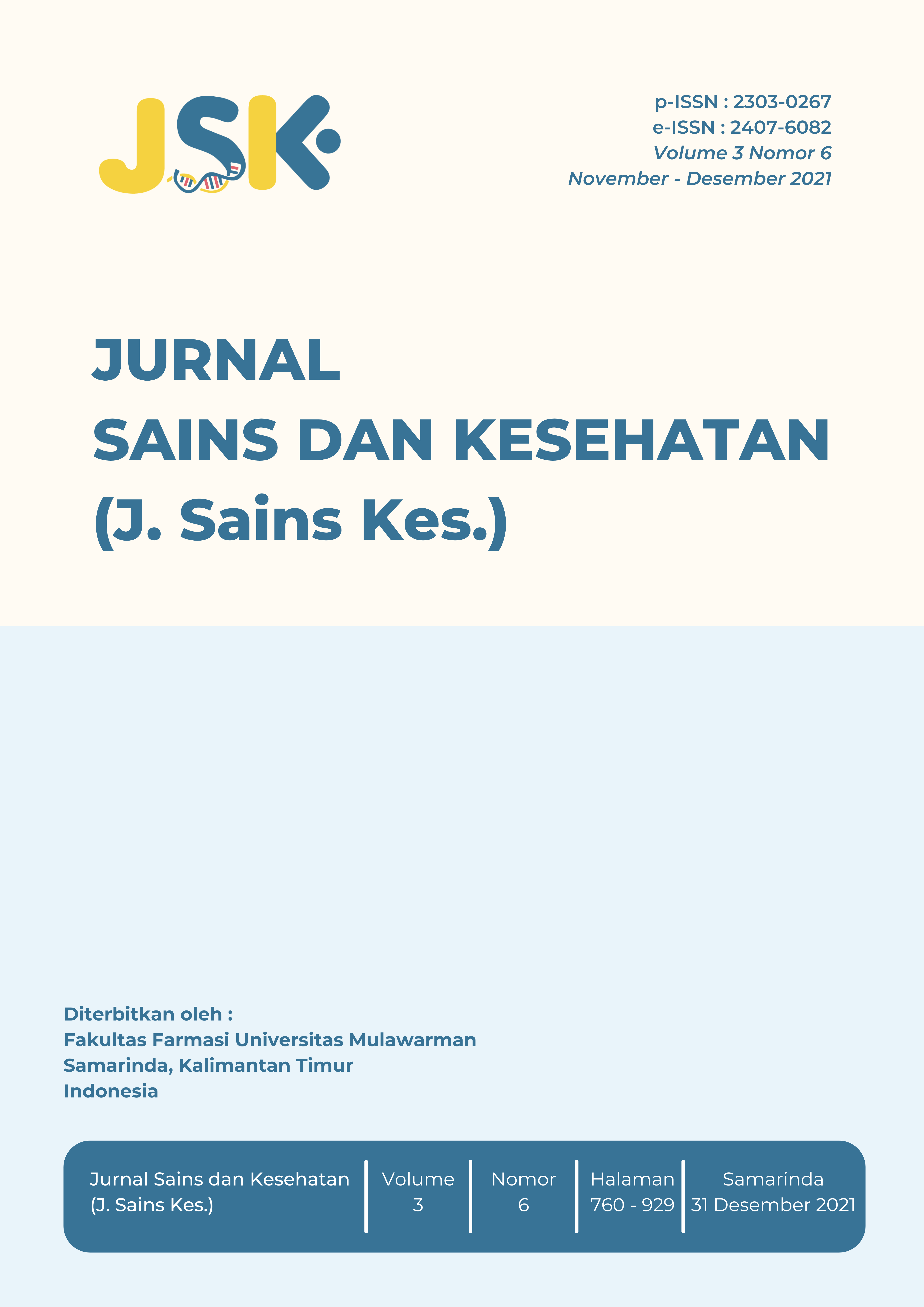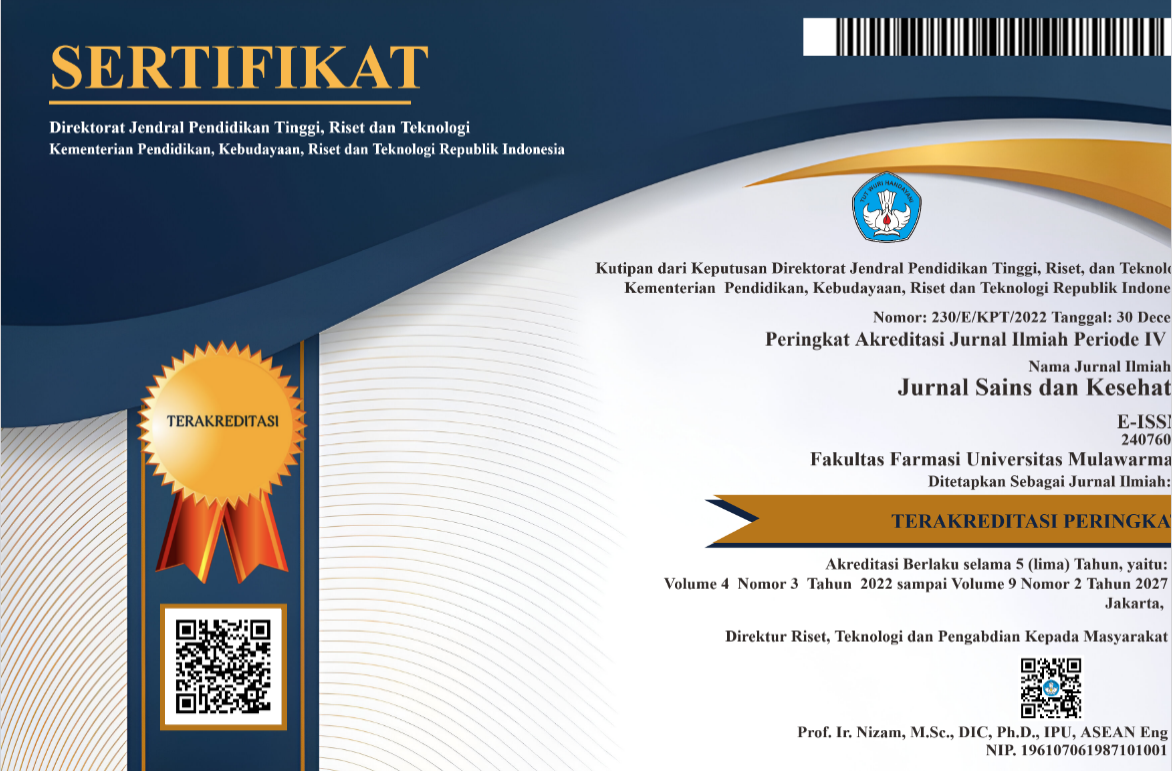Medication Related Burden pada Pasien Gagal Ginjal Kronis di RSUD Kota Yogyakarta
Keywords:
Gagal Ginjal Kronis, medication related burden, kepatuhanAbstract
References
1. Adikusuma, W., Perwitasari, D.A., Supadmi, W., 2014, Evaluasi Kepatuhan Pasien Diabetes Melitus Tipe 2 Di Rumah Sakit Umum Pku Muhammadiyah Bantul, Yogyakarta, Media Farmasi, Vol. 11: 208-220.
2. Agustini, R., 2010, Dampak dukungan keluarga dalam mempengaruhi kecemasan pada pasien penderita gagal ginjal kronis di Rumah Sakit Panti Rapih Yogyakarta, [Online], Sumber: http://skripsi-indonesia.com [Akses: 10 Oktober 2020].
3. Al-Kloub, M.I., A bed, M.A., Al Khawaldeh, O.A., Al Tawarah, Y.M., & Froelicher, E.S., 2014, Predictors of non-adherence to follow-up visits and deferasirox chelation therapy among Jordanian adolescents with Thalassemia major. Pediatric hematology and oncology, 31(7), 624-637.
4. Alya, M.K., 2019, Medication Related Burden pada pasien Thalasemia di Rumah Sakit Umum Pusat DR Hasan Sadikin Bandung, Skripsi, Fakultas Farmasi Universitas Padjadjaran, Bandung.
5. Anonim,2011, Interpretasi data Klinik, Kementrian Kesehatan Republik Indonesia, Jakarta.
6. Costa, E., Giardini, A., Savin, M., Menditto, E., Lehane, E., Laosa, O., Pecorelli, S., Monaco, A. and Marengoni, A., 2015, Interventional tools to improve medication adherence: review of literature. Patient preference and adherence, Volume 9, pp.1303-1314.
7. D’Agostino, T.A., Atkinson, T.M., Latella, L.E., Rogers, M., Morrissey, D., DeRosa, A.P. and Parker, P.A., 2017, Promoting patient participation in healthcare interactions through communication skills training: a systematic review. Patient education and counseling, Volume 100(7), pp.1247-1257.
8. Dipiro, J.T., Rotschafer, J.C., Kolesar, J.M., Malone, P.M.,Schwinghammer, T.L., wells,B.G., Burns, M.A.,2015, Pharmacotheraphy: principles and practice, the McGraw–Hill Companies, New York.
9. Faktul., 2009, Faktor Kepatuhan Pasien, [Online], Sumber: http://www.Bidanlia.kepatuhanpasien.html [Akses: 10 Oktober 2020].
10. Farida, Z., Wakhid, A. and Suwanti, S., 2018, Hubungan Lama Hemodialisa Dengan Tingkat Kecemasan Pada Pasien Gagal Ginjal Kronik Yang Menjalani Hemodialisa Di Rsud Ambarawa Dan Rsud Ungaran Kabupaten Semarang, Doctoral dissertation, Universitas Ngudi waluyo.
11. Elsous, A., Radwan, M., Al-Sharis, H. & Mustafa, A.A., 2017, Medications Adherence and Associated Factors among Patients wit Type 2 Diabetes Mellitus in the Gaza Strip, Palestine. Front Endocrinol, Volume 8, p. 100.
12. Eton, D.T., de Oliveira, D.R., Egginton, J.S., Ridgeway, J.L., Odell, L., May, C.R. and Montori, V.M., 2012, Building a measurement framework of burden of treatment in complex patients with chronic conditions: a qualitative study. Patient related outcome measures, Volume 3, pp.39-49.
13. Evadewi, P.K.R., Sukmayanti, L.M.K., 2013, Kepatuhan mengonsumsi obat pasien hipertensi di Denpasar ditinjau dari kepribadian tipe A dan tipe B, Jurnal Psikologi Udayana, 1(1): 32-42.
14. Gallacher, K., Morrison, D., Jani, B., Macdonald, S., May, C.R., Montori, V.M., Erwin, P.J., Batty, G.D., Eton, D.T., Langhorne, P. and Mair, F.S., 2013, Uncovering treatment burden as a key concept for stroke care: a systematic review of qualitative research. PLoS Med, Volume 10(6), p.e1001473.
15. Gnjidic, D., Tinett, M. & Alloreb, H.G., 2017, Assessing medication burden and polypharmacy: finding the perfect measure. Expert Rev Clin Pharmacol, Volume 10(4), pp. 345-347.
16. Hervinda, S., & Novadian, N., 2014, Prevalensi dan Faktor Risiko Penyakit Ginjal Kronik di RSUP Dr. Mohammad Hoesin Palembang Tahun 2012, Majalah Kedokteran Sriwijaya, 46(4), 275–281.
17. Imanishi, Y., Fukuma, S., Karaboyas, A., Robinson, B.M., Pisoni, R.L., Nomura, T., Akiba, T., Akizawa, T., Kurokawa, K., Saito, A. and Fukuhara, S., 2017, Associations of employment status and educational levels with mortality and hospitalization in the dialysis outcomes and practice patterns study in Japan. PLoS One, Volume 12(3), p.e0170731.
18. Jin, J., Sklar, G.E., Oh, V.M.S. & Li, a. S.C., 2008, Factors affecting therapeutic compliance: A review from the patient’s perspective. Ther Clin Risk Manag, 4(1), pp. 269-286.
19. Johnson, A.B., Sebastian, A., Sudulaguntla, A., Sabu, A.C., Meka, S., Nanjwade, B.K., 2016, Medication Adherence Rating of Patients with Hypertension in A Tertiary Care Hospital, World Journal of Pharmacy and Pharmaceutical Sciences, Vol. 5, Issue 2, 694-710.
20. Kamaluddin, R. and Rahayu, E., 2009, Analisis faktor-faktor yang mempengaruhi kepatuhan asupan cairan pada pasien gagal ginjal kronik dengan hemodialisis di RSUD Prof. Dr. Margono Soekarjo Purwokerto, Jurnal Keperawatan Soedirman, 4(1).
21. Katusiime, B., Corlett, S.A. & Krska, J., 2018, Development and Validation of a Revised Instrument to Measure burden of long-term medicine use: the Living with Medicines Questionnaire version 3. Patient Related Outcomes Measure, Volume 9, pp. 155-168.
22. Krska, J., Morecroft, C.W., Rowe, P.H. & Poole, H., 2014, Measuring the impact of long-term medicines use from the patient perspective. Int J Clin Pharm, Volume 36, pp. 675-678.
23. Kuntjojo, 2009,Psikologi Kepribadian. Universitas Nusantara Kediri, Kediri.
24. Lemeshow, S., Hosmer, D.W., Klar, J. & Lwanga, S.K., 1997,Besar Sampel dalam Penelitian Kesehatan, Yogyakarta: Gadjahmada University Press.
25. Mahler, C., Hermann, K., Horne, R., Ludt, S., Haefeli, W.E., Szecsenyi, J., Jank, S., 2010, Assessing reported adherence to pharmacological treatment recommendations. Translation and evaluation of the Medication Adherence Report Scale (MARS) in Germany, J Eval Clin Pract,16(3):574–579.
Downloads
Published
Issue
Section
How to Cite
Most read articles by the same author(s)
- Fitri Ayu Wahyuni, Woro Supadmi, Endang Yuniarti, Hubungan Karakteristik Pasien dan Rejimen Kemoterapi Terhadap Kualitas Hidup Pasien Kanker di RS PKU Muhammadiyah Yogyakarta , Jurnal Sains dan Kesehatan: Vol. 3 No. 2 (2021): J. Sains Kes.
Similar Articles
- Angga Cipta Narsa, Vina Maulidya, Dea Reggina, Wina Andriani, Hifdzur Rashif Rijai, Studi Kasus: Pasien Gagal Ginjal Kronis (Stage V) dengan Edema Paru dan Ketidakseimbangan Cairan Elektrolit , Jurnal Sains dan Kesehatan: Vol. 4 No. SE-1 (2022): Spesial Edition J. Sains Kes.
- Silvanus Giovanny Bunga Allo, Meiliati Aminyoto, Yuliana Rahmah Retnaningrum, Hubungan Status Gizi dan Kepatuhan Diet dengan Kualitas Hidup pada Pasien Penyakit Ginjal Kronis yang Menjalani Hemodialisis Rutin di RSUD Abdul Wahab Sjahranie Samarinda , Jurnal Sains dan Kesehatan: Vol. 2 No. 4 (2020): J. Sains Kes.
- Novianty Indjar Gama, Ferdian George Sarung Allo, Fahriani Istiqomah, Angga Cipta Narsa, Laporan Kasus: Kajian Pengobatan CKD Stage 5 dengan Hiperkalemia , Jurnal Sains dan Kesehatan: Vol. 4 No. SE-1 (2022): Spesial Edition J. Sains Kes.
- Yacomina Kuway, Tressia Sujana, Rifatolista Tampubolon, Hubungan Kepatuhan Hemodialisis dengan Disfungsi Seksual Wanita Usia Subur di RSUD Ungaran , Jurnal Sains dan Kesehatan: Vol. 3 No. 1 (2021): J. Sains Kes.
- Joses Michael Korin, Eka Yuni Nugrahayu, Nirapambudi Devianto, Hubungan Lama Menjalani Hemodialisis dengan Tingkat Depresi pada Pasien Hemodialisis di RSUD Abdul Wahab Sjahranie Samarinda , Jurnal Sains dan Kesehatan: Vol. 2 No. 4 (2020): J. Sains Kes.
- Reny Anggriany Hakim, Delina Hasan, Aritonang Aritonang, Analisis Efektivitas Biaya Hemodialisa dan Peritoneal Dialisa pada Pasien Gagal Ginjal Kronik Di Rumah Sakit Umum Pusat Fatmawati Jakarta 2019 , Jurnal Sains dan Kesehatan: Vol. 2 No. 4 (2020): J. Sains Kes.
- Agustiqori Al-Mubarak, Diana Kurnia Apriani, M. Yudha Pratama, M. Wahyu Ariawan, Dalifa Ramadhani, Muh. Deni Kurniawan, Debi Dinha Octora, Pengaruh Dukungan Keluarga Terhadap Tingkat Kepatuhan Minum Obat Pasien Tuberkulosis Paru Puskesmas Kecamatan Tenggarong , Jurnal Sains dan Kesehatan: Vol. 6 No. 3 (2025)
- Ana Amalia, Nurdiana Mufida Apriliani, Analisis Efektivitas Single Use dan Reuse Dialyzer pada Pasien Gagal Ginjal Kronik di RSUD Mardi Waluyo Kota Blitar , Jurnal Sains dan Kesehatan: Vol. 3 No. 5 (2021): J. Sains Kes.
- Nurul Handayani, Muhammad Faisal, Rolan Rusli, Kajian Interaksi Obat pada Pasien Gagal Ginjal Rawat Inap di RSUD Panglima Sebaya Tanah Grogot , Jurnal Sains dan Kesehatan: Vol. 5 No. 4 (2023): J. Sains Kes.
- Betty Rachma, Ani Widyastuti, Hubungan Kadar Hemoglobin Terglikosilasi (HbA1c) dengan Estimasi Laju Filtrasi Glomerulus (eLFG) Pasien DM Tipe II di Fasilitas Kesehatan Tingkat Pertama , Jurnal Sains dan Kesehatan: Vol. 3 No. 4 (2021): J. Sains Kes.
You may also start an advanced similarity search for this article.




